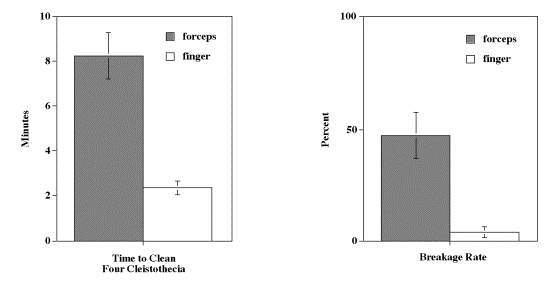
Even seasoned workers find it tedious and sometimes frustrating to remove Hülle cells and stray conidia from Aspergillus cleistothecia by rolling them with forceps across an agar surface, particularly when large numbers must be cleaned. It can be even more challenging to teach the skill to others, especially to a whole class of easily discouraged undergraduates, who may be seeing their first high-mag image of forceps tips at the same time as their first view of a cleistothecium. The tips of forceps are sharp and rough, and the hands that wield them often shaky. A peridium is no match for an ill-aimed poke or slash. We find, however, that cleistothecia can be cleaned very rapidly, with reduced breakage, and with minimal contamination by doing away with forceps altogether and using instead the tools that nature gave us “at our fingertips”.Indeed they are our fingertips themselves.
The method is simply to roll cleistothecia briefly and firmly around the surface of a 4% agar plate (with or
without diatomaceous earth per Kaminskyj and Hamer, 1996, Fungal Genetics
Newsletter 43:71) beneath a well-cleaned fingertip. A few seconds’
rubbing in a circle about an inch in diameter is all that is required. The pressure of the finger is spread evenly,
and the cleistothecia only rarely break. For increased efficiency, several cleistothecia can be rubbed at once
beneath a single fingertip. Soap-and-water washing, followed by two or three 10-second immersions of
the finger in 95% alcohol, with Kimwipe-drying after each immersion, is
sufficient in our experience to reduce levels of bacterial contamination to no
more than those observed when using flamed forceps – i.e., essentially none.
The following figures compare the “fingertip” and “forceps” methods, using two measures of
efficiency – speed of cleaning and amount of breakage.

A class of 15 students, already experienced in cleaning cleistothecia by traditional means, was instructed to isolate four cleistothecia using forceps (dark bars) and then, after a brief introduction to the method, to isolate another four using fingertips (light bars).The “fingertip” method cut cleaning time by over 70%, and the rate of cleistothecium breakage was cut by over 90%.The effectiveness of cleaning was attested to both by microscopic observation of peridial surfaces and by finding the expected phenotypic ratios amongst the progeny (data not shown).The numbers of bacterial colonies appearing on ascospore spread plates were very low, and comparable with both methods.
Return to the FGN 50 Table of Contents